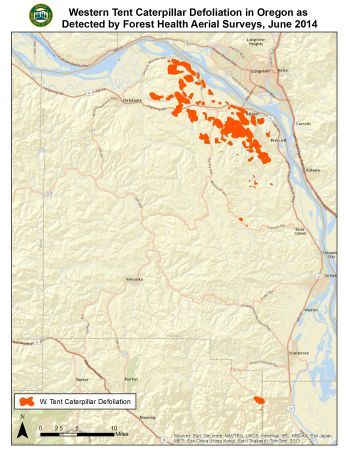
Publisher:
Bonnie King
CONTACT:
Newsroom@Salem-news.com
Advertising:
Adsales@Salem-news.com

~Truth~
~Justice~
~Peace~
TJP
Jun-19-2014 19:54

 TweetFollow @OregonNews
TweetFollow @OregonNews
Parts of Oregon Inundated by Western Tent Caterpillars
Salem-News.com StaffWestern tent caterpillars produce one generation per year.
 Areas of Columbia County where defoliation by western tent caterpillars was observed, as detected by aerial survey. Map Courtesy: Rob Flowers, ODF |
(SCAPPOOSE, Ore. ) - Oregon State University Extension offices in Columbia County are being inundated with calls by concerned members of the public about localized, often severe, defoliation of hardwoods in the northern portion of the county.
The defoliation has been most noticeable on red alders, cottonwoods, willows and fruit trees; however, other broadleaf trees and shrubs are also being affected.
The damage is caused by an outbreak of western tent caterpillars (Malacosoma californicum), a moth native to the Pacific Northwest.
Affected areas are conspicuous by the defoliation that has occurred due to larval feeding, and on closer inspection by the presence of the caterpillars themselves, which are often located in or near silken "tents" they construct within the tree.
Outbreaks by this insect are common; forest health aerial surveys indicate the last large outbreak in northwest Oregon occurred in 2001-2002. This year, more than 13,000 acres of aerially-observable defoliation have been detected making this the largest documented outbreak in Oregon in the last two decades.
The affected area observed to date extends from north of Rainier to south of Scappoose and west to Clatskanie. Damage has also been reported in areas of southwest Washington but aerial surveys have not yet been completed this year. Damage within affected areas is highly variable, ranging from trees that appear to be almost completely defoliated to areas with only light defoliation.
Lifecycle
Western tent caterpillars produce one generation per year. The larvae emerge in the spring near bud-break, feed initially as a colony, and construct silken "tents" within their host plants. Larvae usually mature in about 30-40 days and abandon the tents to construct silken cocoons in which they pupate; this usually takes place on or beneath affected trees. The emergence of adult moths, mating, and egg-laying usually occurs during July and August.
Landowner concern
Landowners in the vicinity of the current outbreak area have reported huge numbers of larvae leaving their host trees and moving down onto lawns, homes and other structures. This often occurs as the caterpillars attempt to locate additional foliage to feed on or find a suitable pupation site. While this can certainly be a nuisance to homeowners, this insect does not represent any significant risk to human health or pets. In the coming weeks, landowners in affected areas should be prepared to see large numbers of moths emerging; the moths will also be strongly attracted to any lights in the area.
Long-term damage usually only minor
Although some trees may be completely defoliated at this point, long-term damage from western tent caterpillar is usually only minor. Historically, outbreaks have been short-lived, persisting for only 1-2 years in a given area due to the combined effects of natural enemies (parasites and predators), diseases, larval starvation, and in some cases adverse weather. Parasitic wasps and a virus have been identified as among the most significant natural control agents of western tent caterpillars, and will quickly return outbreak populations to low levels.
Given the degree of tolerance that most trees exhibit and the short-duration of the infestations, outbreaks in forest areas are generally allowed to run their course. Where they are affecting residential or recreation areas, non-chemical management is the best choice. Larvae can be removed by high-pressure sprays, pruning, or other techniques manually.
One technique that is not recommended is to attempt to burn the tents, which can cause significant tree damage. Proper cultural care of affected landscape trees will also help to reduce stress and allow them to recover from the effects of defoliation. There are a number of insecticides registered for control of western tent caterpillar in Oregon, but biological products containing Bacillus thuringiensis (Bt) or spinosad are recommended due to their lower impacts on natural enemies and other non-targets.
However, it is best to time these applications to when the caterpillars are young and before extensive feeding has occurred. Attempting to treat older larvae, which are occurring in most areas now, is generally not recommended as the majority of feeding has already occurred.
Additional aerial surveys in southwest Washington are planned to further document the locations and severity of the current outbreak.
Source: Oregon Department of Forestry
Articles for June 18, 2014 | Articles for June 19, 2014 | Articles for June 20, 2014
Quick Links
DINING
Willamette UniversityGoudy Commons Cafe
Dine on the Queen
Willamette Queen Sternwheeler
MUST SEE SALEM
Oregon Capitol ToursCapitol History Gateway
Willamette River Ride
Willamette Queen Sternwheeler
Historic Home Tours:
Deepwood Museum
The Bush House
Gaiety Hollow Garden
AUCTIONS - APPRAISALS
Auction Masters & AppraisalsCONSTRUCTION SERVICES
Roofing and ContractingSheridan, Ore.
ONLINE SHOPPING
Special Occasion DressesAdvertise with Salem-News
Contact:AdSales@Salem-News.com

googlec507860f6901db00.html



Terms of Service | Privacy Policy
All comments and messages are approved by people and self promotional links or unacceptable comments are denied.
[Return to Top]
©2025 Salem-News.com. All opinions expressed in this article are those of the author and do not necessarily reflect those of Salem-News.com.